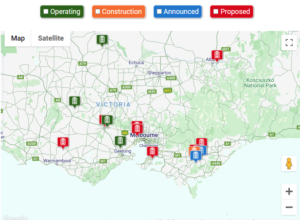CLEAN ENERGY ON THE RISE
Globally, renewable energy is growing faster than ever. By 2026, renewable energy is predicted to have grown more than 60% from 2020 levels. Investment in renewable energy capacity continues to outpace investment in fossil fuels. The trend is clear – wind and solar power are growing at extraordinary rates. Clean energy is taking over.
IN VICTORIA: GRID PRICES AND RELIABILITY
The wind blows for free and the sun shines for nothing, so once renewable energy projects are built they are very cheap to run. This means they can provide electricity at much lower cost than coal power, and ultimately this will push household electricity prices down. The Australian Energy Market Commission estimates that the influx of battery storage and renewables will cut wholesale electricity prices by 39% by 2024.
Replacing old coal with renewables will also make our grid more reliable. Victoria’s coal burning power stations are the most unreliable in the country. In their first 18 months of monitoring power plant breakdowns, the Australia Institute found that two Victorian power stations suffered more outages that any others in Australia. Between December 2017 and June 2019, Loy Yang A broke down 29 times, closely followed by Yallourn which broke down 26 times.
This is a huge risk to our energy security, particularly over hot summer months when demand is high and coal generators are more vulnerable to failing in the heat. Upgrading our grid and building more modern clean energy and storage to replace old coal power will ensure power is reliably available when we need it most.
BATTERIES CHARGING AHEAD
Batteries store energy when the sun is shining and wind is blowing and can then release it at times of high demand, making our grid more reliable and enabling more power to come from wind and solar, the cheapest forms of energy. The cost of battery storage has dropped significantly in recent years and the rapid growth in big batteries around Victoria is accelerating our transition to renewable energy.
For a view of all the battery projects around Australia, check out the interactive version of this map from Renew Economy.

Battery storage projects around Victoria
ROOFTOP SOLAR
The growth in rooftop solar power also plays a key role in reducing strain on the electricity grid at peak times. As many as one in five homes have solar panels and together generate a third of Victoria’s total residential electricity demand. The Solar Homes program, launched by the state government in 2018, aims to install solar panels on the roofs of 650,000 Victorians over 10 years. The benefits are enormous:
- Households with solar panels can save up to $890 a year on electricity and another $640 with a battery.
- The more solar we have, the better the grid will cope during summer heatwaves.
- An increase in rooftop solar will mean more clean, renewable energy available as old coal-burning power stations are retired.
TRANSITION TO 100% CLEAN ENERGY
In 2019-20, renewable energy generated almost 25% of electricity in Victoria, and we’re already on track to beat the target of 50% renewable energy by 2030. But to do our bit in meeting the Paris Agreement to limit global temperature rises to 1.5 degrees, Victoria must aim to cut emissions from the energy sector much faster, with a goal to achieve 100% renewable electricity generation by 2030.
more about Victoria’s Renewable Energy TargeT
The transition to clean energy is happening more quickly than anyone predicted when Victoria’s target of 50% renewables by 2030 was set. Renewable power is now more reliable than ever and is cheaper, cleaner, and safer than coal. Increasing the 2030 target to 100% renewable electricity generation will ensure we don’t lose momentum in the shift to clean energy.